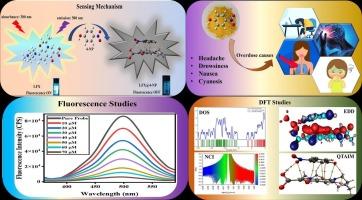AIEE活性左氧氟沙星对4-硝基酚传感的机理:一项结合实验和DFT/TD-DFT的现场应用研究
IF 4.6
2区 化学
Q1 SPECTROSCOPY
Spectrochimica Acta Part A: Molecular and Biomolecular Spectroscopy
Pub Date : 2025-10-06
DOI:10.1016/j.saa.2025.127028
引用次数: 0
摘要
对fda批准的药物左氧氟沙星(LFX)的光物理性质进行了研究,其在更高波长下的精细发射响应促使我们将其用作环境中有害化学物质的传感器。LFX在DMF中完全溶解,在300 nm处最大吸收(λabs),在500 nm处最大发射(λmax)。通过TD-DFT计算,对LFX的发射和吸收进行了理论分析,并对结果进行了比较。LFX表现出溶剂致变色,其波长在各种溶剂存在下发生变化。LFX的发射也在不同的水馏分(0 - 90%)中进行了检测,它的发射响应表明它是一个AIEE活性分子,因为它的发射强度在水存在时增强。在DMF: H2O (1:7, v/v)对4-NP类似的条件下,LFX对各种nac、金属离子和阴离子进行荧光滴定实验,考察其感应能力。LFX强度仅在4-NP相互作用下被淬灭,检测限为204 nM。紫外可见。1H NMR滴定实验也研究了4-NP与LFX之间的相互作用类型。此外,通过理论计算研究了LFX和LFX@4-NP的各种电子性质,包括态密度(DOS)电子密度差(EDD),并通过非共价相互作用(NCIs)分析阐明了相互作用的类型。此外,LFX传感器实际应用于实际水样中的4-NP检测,其淬火效率为96%。本文章由计算机程序翻译,如有差异,请以英文原文为准。

Mechanistic insights into AIEE active levofloxacin for 4-nitrophenol sensing: A combined experimental and DFT/TD-DFT study with on-site applications
The photophysical properties of the FDA-approved drug levofloxacin (LFX) were studied, and its exquisite emission response at higher wavelengths prompted us to utilize it as a sensor against hazardous chemicals in the environment. LFX was fairly soluble in DMF and showed the maximum absorption (λabs) at 300 nm wavelength and maximum emission (λmax) at 500 nm wavelength experimentally. Both the emission and absorption of LFX were also theoretically examined through TD-DFT calculations, and the results were compared. LFX exhibits solvatochromism as its wavelength changes in the presence of various solvents. The emission of LFX was also checked in varying water fractions (0˗90 %), and its emission response demonstrates it as an AIEE active molecule, as its emission intensity is enhanced in the presence of water. The fluorescence titration experiment of LFX was performed against various NACs, metal ions, and anions to check its sensing capability under the similar conditions DMF: H2O (1:7, v/v) as utilized for 4-NP. The LFX intensity was quenched only upon the interaction of 4-NP and showed a limit of detection of 204 nM. UV–Vis. 1H NMR titration experiments were also performed to investigate the type of interaction between 4-NP and LFX. Furthermore, theoretical calculations were performed to study various electronic properties of LFX and LFX@4-NP including density of state (DOS) electron density difference (EDD) and the type of interactions were elucidated by performing the non-covalent interaction (NCIs) analysis. Moreover, the sensor LFX was practically utilized in sensing the 4-NP in a real water sample, which showed a 96 % quenching efficiency.
求助全文
通过发布文献求助,成功后即可免费获取论文全文。
去求助
来源期刊
CiteScore
8.40
自引率
11.40%
发文量
1364
审稿时长
40 days
期刊介绍:
Spectrochimica Acta, Part A: Molecular and Biomolecular Spectroscopy (SAA) is an interdisciplinary journal which spans from basic to applied aspects of optical spectroscopy in chemistry, medicine, biology, and materials science.
The journal publishes original scientific papers that feature high-quality spectroscopic data and analysis. From the broad range of optical spectroscopies, the emphasis is on electronic, vibrational or rotational spectra of molecules, rather than on spectroscopy based on magnetic moments.
Criteria for publication in SAA are novelty, uniqueness, and outstanding quality. Routine applications of spectroscopic techniques and computational methods are not appropriate.
Topics of particular interest of Spectrochimica Acta Part A include, but are not limited to:
Spectroscopy and dynamics of bioanalytical, biomedical, environmental, and atmospheric sciences,
Novel experimental techniques or instrumentation for molecular spectroscopy,
Novel theoretical and computational methods,
Novel applications in photochemistry and photobiology,
Novel interpretational approaches as well as advances in data analysis based on electronic or vibrational spectroscopy.

 求助内容:
求助内容: 应助结果提醒方式:
应助结果提醒方式:


